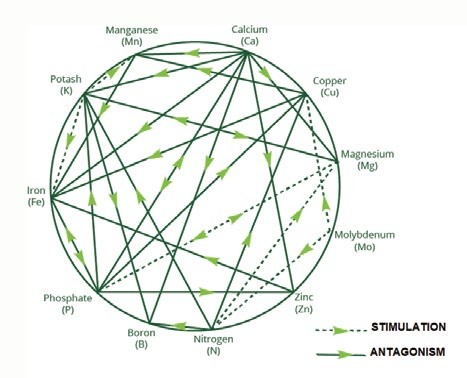Mulder’s Chart
Mulder’s Chart is a useful tool for understanding how different essential plant nutrients interact, either helping or hindering nutrient uptake and utilisation. These interactions can significantly affect crop health and yield, so it’s important to be aware of both stimulating and antagonistic relationships between nutrients.
Antagonism: When certain nutrients are present in high levels in the soil, they can block the uptake of other essential nutrients. For instance, excess nitrogen can limit the availability of boron, potassium, and copper. Another example of antagonism is calcium. If there is too much calcium, it can either outcompete other nutrients like potassium and magnesium for uptake sites on the roots, or it can raise the soil pH, making iron and boron less available to the plant.
Stimulation: A high concentration of one nutrient can increase the plant’s demand for another. For example, an increase in nitrogen levels can cause the plant to require more magnesium.

Using Mulder’s Chart can help you balance nutrient applications in your vegetable crops to avoid imbalances that could limit growth and yield.
The most common nutrient interaction issue in vegetable crops is often the antagonism between potassium (K) and magnesium (Mg). Many vegetable growers apply potassium to enhance fruit quality, particularly in crops like tomatoes, peppers, and cucumbers. However, excess potassium can interfere with the plant’s ability to absorb magnesium, which is crucial for photosynthesis and healthy leaf development. Magnesium deficiency appears as yellowing between the veins of older leaves (interveinal chlorosis) and can lead to poor fruit development and reduced yields.